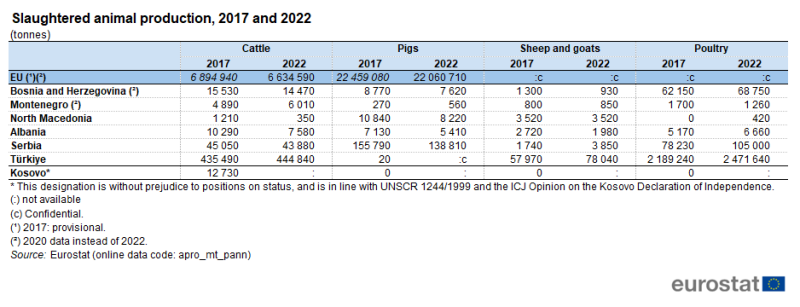Enlargement countries - agriculture, forestry and fisheries statistics
Data extracted in April 2023.
Planned article update: May 2024.
Highlights
In 2021, the contribution of agriculture, forestry and fisheries to the gross value added in the Western Balkans and Türkiye varied between 5.6 % in Bosnia and Herzegovina and 21.3 % in Albania, compared with 1.9 % in the EU.
In Albania, employment in agriculture, forestry and fisheries as share of total employment fell from 40.2 % in 2016 to 33.8 % in 2021; in Bosnia and Herzegovina it declined by a little less than half from 18.0 % to 9.4 % over the same period.
Total cereals production in the Western Balkans and Türkiye amounted to 45.3 million tonnes in 2021, corresponding to 15.2 % of the cereals production in the EU (297.5 million tonnes).
Employment in agriculture, forestry and fisheries, 2016 and 2021
This article is part of an online publication and provides information on a range of statistics for the agriculture, forestry and fisheries sectors of the European Union (EU). Within this region, Bosnia and Herzegovina, Montenegro, North Macedonia, Albania, Serbia and Türkiye are candidate countries, while Kosovo has the status of potential candidate.
Data for Georgia, Moldova and Ukraine, granted candidate status or European perspective by the European Council in June 2022, are not included in this article; Statistics Explained articles on the European Neighbourhood Policy-East countries are available here.
The article provides an overview of recent developments in the Western Balkans and Türkiye, presenting indicators such as the relative importance of agriculture, forestry and fisheries in terms of their contribution to gross value added and employment. It also provides more detailed data on agricultural land use, agricultural production, livestock populations and meat production, as well as trade in food, live animals, drinks and tobacco.
* This designation is without prejudice to positions on status, and is in line with UNSCR 1244/1999 and the ICJ Opinion on the Kosovo Declaration of Independence.
Full article
Gross value added and employment
Agriculture, forestry and fisheries generate a considerably higher share of value added in Western Balkans and Türkiye than in the EU
In 2022, agriculture, forestry and fisheries contributed considerably more to gross value added in the Western Balkans and Türkiye than in the EU (see Figure 1). Bosnia and Herzegovina recorded the lowest share in 2022 at 5.6 %, followed by Türkiye (7.2 %). Montenegro recorded provisional share of 7.9 %, Serbia's share was 8.2 % followed by two more Western Balkans countries with shares of 9.0 % in North Macedonia and 9.2 % in Kosovo. These activities contributed to more than one-fifth of gross value added (21.3 %) in Albania in 2022, by far the highest share among the Western Balkans and Türkiye. From 2012 to 2022, the share of value added from these activities in the total declined in all of the Western Balkans and Türkiye, except of Serbia with a small increase (+0.6 percentage points (pp)) and Kosovo, which share remained at the level of 2012 (+0.05 pp). The largest fall (-1.6 pp) was recorded in Bosnia and Herzegovina, followed by Türkiye, North Macedonia (both -1.5 pp) and Montenegro (-1.0 pp). The importance of these activities to the economy of Albania diminished only to a smaller degree, declining by -0.3 pp between 2012 and 2022. In 2022, the relative contribution of agriculture, forestry and fisheries to gross value added in the EU economy stood at 1.9 % the same share was registered in 2012.
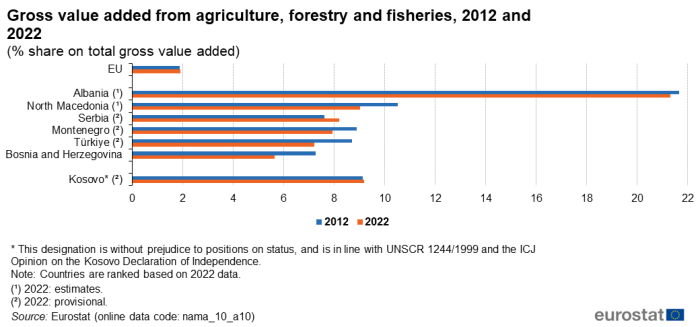
(% share on total gross value added)
Source: Eurostat (nama_10_a10)
Among the Western Balkans and Türkiye, Kosovo (2.8 %) recorded the lowest share of agriculture, forestry and fisheries in total employment in 2021. The 6.6 % share in Montenegro (2020 data) and the 9.4 % share in Bosnia and Herzegovina were the only other employment shares below 10 % (see Figure 2). By contrast, the high importance of agriculture, forestry and fisheries to the economy of Albania was also reflected in its employment structure: in 2020 (no 2021 data available), employment in these activities made up more than one-third (33.8 %) of total employment in the country. In the other Western Balkans and Türkiye, the workforce employed in agriculture, forestry and fisheries activities represented between 11 % and 17 % of total employment: in North Macedonia, the share was 11.1 % in 2020 (no 2021 data available), in Serbia 12.5 % and in Türkiye 16.2 %.
Nevertheless, the importance of agriculture, forestry and fisheries for employment was diminishing in these countries. From 2016 to 2021, these activities' contribution to total employment decreased by -8.5 pp in Bosnia and Herzegovina, by -6.5  in Albania, by -4.7 pp in North Macedonia (from 2016 to 2020), and by -3.9 pp in Serbia. The decreases in these shares were somewhat smaller for Türkiye (-1.9 pp) and Montenegro (-0.5 pp) from 2016 to 2020 (2021 data not available for these two countries). In Kosovo the share of agriculture, forestry and fisheries in total employment decreased by 1.4 pp from 4.2 % in 2016 to 2.8 % in 2021.
Employment in agriculture, forestry and fisheries in the EU accounted for 3.6 % of the total number of persons employed in 2021; this was 1.9 times the contribution of the gross value added of these activities to total gross value added in the same year (1.9 %). However, the contribution of these activities to the overall workforce had decreased since 2016, by -0.9 pp.
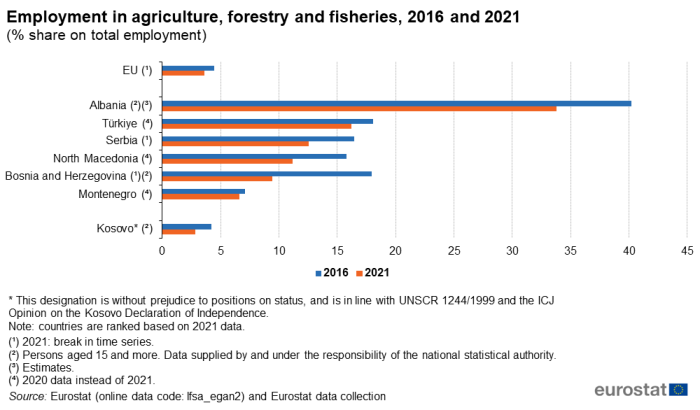
(% share on total employment)
Source: Eurostat (lfsa_egan2) and Eurostat data collection
Land use
Half of the area of North Macedonia is used for agriculture
The area that is used for agriculture varies according to climate, terrain and soil type, while the level of economic development and population density may also play a role in determining land use. Within the EU, roughly two-fifths of the total land area are used for agriculture. The remainder of the land is generally composed of wooded land, built-up areas (villages, towns and cities), infrastructure (roads or railways), scrub or waste land.
The utilised agricultural area (UAA) refers to the area that is actually used for agricultural purposes. In 2021, the combined utilised agricultural area for the Western Balkans and Türkiye was around 46.5 million hectares, equivalent to 28.7 % of the total utilised agricultural area in the EU (2020 data). Among the Western Balkans and Türkiye, Türkiye had by far the largest utilised agricultural area, with 38 million hectares in 2021. Relative to their total area, North Macedonia and Türkiye recorded the highest proportions utilised for agricultural purposes in 2021 (49.9 % and 48.7 %, respectively), followed by Albania (40.5 %) (see Figure 3). In Serbia (39.6 %), the share was over one-third. In Kosovo (38.6 %), the share of utilised agricultural area was similar to that in the EU (38.3 % - 2020 data), with the level estimated in Bosnia and Herzegovina slightly lower at 36.4 %. Montenegro registered by far the lowest share, with less than one-fifth (18.4 %) of its total land area used for agricultural activities.
The utilised agricultural area, just as the production of agricultural products, typically varies somewhat from year to year, reflecting climatic, meteorological and hydrological conditions, market conditions, crop rotation, the share of permanent crops, pests, etc. Compared with 2011, the share of UAA in the total area had decreased in Albania (-1.2 pp), Serbia (-0.5 pp) and Türkiye (-0.2 pp). By contrast, the share of UAA had increased substantially in North Macedonia (+5.8 pp) and, to a lesser degree, in Bosnia and Herzegovina (+2.6 pp), Montenegro (+2.4 pp) and Kosovo (+1.2 pp). In the EU, the share of UAA slightly decreased by 0.2 pp between 2011 and 2020 (no 2021 data available).
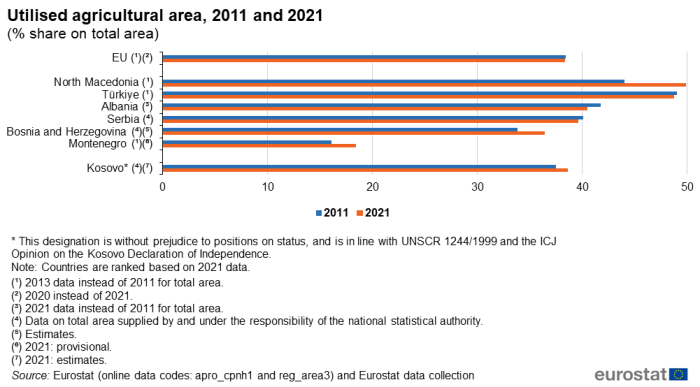
(% share on total area)
Source: Eurostat (apro_cpnh1) and (reg_area3) and Eurostat data collection
Agricultural production
The production of cereals in Western Balkans and Türkiye corresponded to 15 % of the EU production in 2021
In 2021, the combined production of cereals by the Western Balkans and Türkiye exceeded 45 million tonnes, equivalent to 15.2 % of the output of the EU which amounted to 297.5 million tonnes (see Table 1). For potatoes, the combined production of the Western Balkans and Türkiye (6.6 million tonnes) was equivalent to 13.1 % of the EU total, with production concentrated in Türkiye, with 5.1 million tonnes.
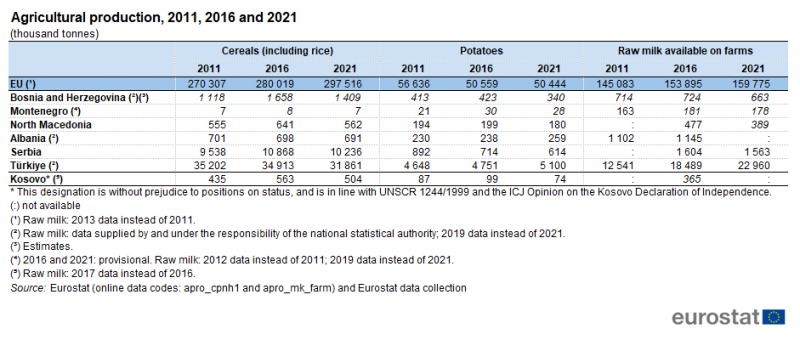
(thousand tonnes)
Source: Eurostat (apro_cpnh1) and (apro_mk_farm) and Eurostat data collection
Crop production levels can fluctuate substantially from year to year as a result of climatic/weather conditions and variations in demand. Apart from Albania, production of cereals was higher in 2021 than in 2011 in all the Western Balkans; the same applied to the EU. The production of cereals also decreased in Türkiye over the same period (-9.5 %). Together, Türkiye and Serbia made up 93 % of the total quantity of cereals produced in these countries, with Türkiye accounting for 70 % and Serbia for 23 %. The other Western Balkans contributed only minor quantities of cereals: Bosnia and Herzegovina provided 3.1 % of the total tonnage produced in the region in 2021, Albania 1.5 %, North Macedonia 1.2 %, Kosovo 1.1 % and Montenegro a marginal share (0.02 %).
When studying the production of potatoes throughout the region in 2021, it was also dominated by Türkiye with more than three quarters (77.3 %) of the total. However, the remaining production volumes were more evenly distributed across the Western Balkans. Again, Serbia was the second most important producer in the region with 9.3 % of the total potato production, while Bosnia and Herzegovina (5.2 %), Albania (3.9 %) and North Macedonia (2.7 %) also contributed notable production volumes. However, Kosovo (1.1 %) and Montenegro (0.4%) had only limited production of potatoes.
The EU registered a decrease in the production of potatoes between 2011 and 2021 by -10.9 %, corresponding to a decrease of 6.2 million tonnes to 50.4 million tonnes. Serbia registered a decrease in production by more than one quarter (-31.2 %) over the period 2011-2021, with production falling also in Bosnia and Herzegovina (-17.7 %), Kosovo (-15.0 %) and North Macedonia (-7.2 %). By contrast, the other countries registered substantial growth in potatoes production, ranging between 9.7 % in Türkiye to 29.8 % in Montenegro, with Albania (12.5 %) also within this range.
Türkiye had by far the highest production of raw milk available on farms (which may include milk other than cows' milk), with 23.0 million tonnes in 2019 (latest data available). In 2021, the raw milk production was 1.6 million in Serbia. No data is available for Albania in 2021 but the production was 1.1 million tonnes in 2016 (latest data available). The production of raw milk was less than 1 million tonnes in each of the other countries. Türkiye recorded a substantial increase in milk production between 2011 and 2019 (+83.1 %).
In the EU, the production of raw milk was 10.1 % higher in 2021 (159.8 million tonnes) than it was in 2011 (145.1 million tonnes).
Livestock: population structure and production
Climatic and cultural characteristics in the Western Balkans and Türkiye are reflected in their livestock and meat production
The structure of livestock populations in the Western Balkans and Türkiye is presented in Figure 4. In 2021, Serbia had the highest number of pigs amongst these countries, with 2.9 million, corresponding to three quarters (74.8 %) of the population of pigs in the Western Balkans and Türkiye. For cattle, sheep and goats, the highest livestock populations in the region were all found in Türkiye: 18.0 million cattle (89.4 % of the total), 45.2 million sheep (89.7 %) and 12.3 million goats (91.3 %). It should be noted that 2020 were used instead of 2021 for Bosnia and Herzegovina. In comparison, there were 75.7 million cattle, 141.7 million pigs, 60.6 million sheep and 11.7 million goats in the EU in 2021. The number of goats in Türkiye was 5.3 % higher of the total number of goats in the EU in 2021.
Among the Western Balkans and Türkiye, Serbia was the only one where pigs made up the largest number of livestock population in 2021. More than half (51.1 %) of the livestock population in Serbia was made up by pigs. By contrast, farmers in Kosovo were specialised in raising cattle, which made up almost half (47.4 %) of its total livestock population in 2021. In the other countries, the most common form of livestock was sheep, with shares from 49.2 % in Bosnia and Herzegovina (2020 data) to 59.8 % in Türkiye; North Macedonia (59.0 %), Montenegro (57.1 %) and Albania (53.8 %) also fall into this group. Albania had the highest share of goats among the Western Balkans and Türkiye (28.2 %). However, the highest number of goats in the region were recorded in Türkiye by far. Some of the differences between countries regarding the structure of their livestock populations reflect religious, cultural or traditional practices, in particular with respect to the consumption of pig meat.
Roughly close to one half (48.9 %) of the livestock population in the EU in 2021 was made up by pigs; one quarter (26.1 %) by cattle; one-fifth (20.9 %) by sheep; and the remainder (4.0 %) by goats.
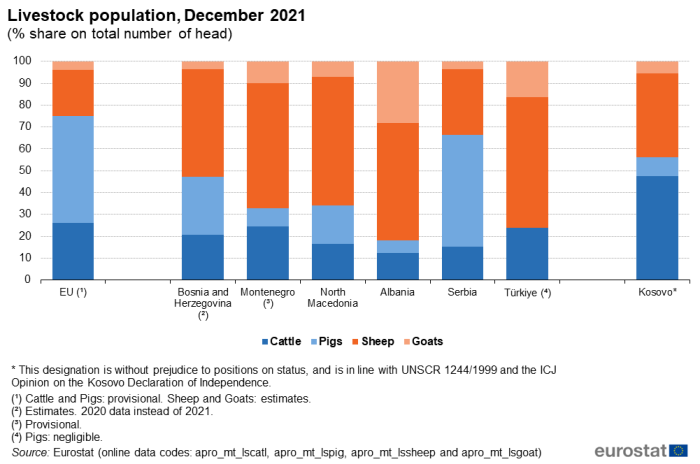
(% share on total number of heads)
Source: Eurostat (apro_mt_lscatl), (apro_mt_lspig), (apro_mt_lssheep) and (apro_mt_lsgoat)
The livestock figures shown in Figure 4 are reflected in the meat production figures in Table 2, notably in the relatively low level of pig meat production in some Western Balkans and Türkiye. The quantity of pig meat (22.1 million tonnes) produced in the EU in 2022 was 3.3 times as high as the quantity of meat from the slaughter of cattle (6.6 million tonnes). Among the Western Balkans and Türkiye, a similar ratio was observed for Serbia (3.2), while it was much higher in North Macedonia, where pig meat production was more than 23 times as high as production of meat from cattle. By contrast, less pig meat than meat from cattle was produced in Albania, Montenegro and Bosnia and Herzegovina. Turkish data on pig meat are confidential for 2022 but in 2020 no production of pig meat was reported by Türkiye. No data on production of pig meat are available for Kosovo for 2022.
By contrast, Türkiye alone reported output of 2.5 million tonnes of poultry meat from slaughtering in 2022; this represented 93.1 % of the total for the Western Balkans and Türkiye. Recent data for Kosovo are only available for slaughter of cattle.
Compared with 2017, the levels of poultry slaughtering increased substantially in almost all the Western Balkans and Türkiye. The exception was Montenegro with a 26 % decline between 2017 and 2020 (more recent data not available). North Macedonia reported no slaughtering of poultry in 2017 and 420 tonnes in 2022. Production of poultry meat Increased in Serbia (+34 %), Albania (+29 %), Türkiye (+13 %) and Bosnia and Herzegovina (+11 %). Kosovo reported no slaughtering of poultry in 2017 and 2022 data is not available for this country.
By contrast, the quantity of slaughtered cattle decreased substantially in North Macedonia (-71.1 %) and Albania (-26.3 %) from 2017 to 2022. The output of meat from slaughtering of pigs decreased in North Macedonia (-24.2 %), Albania (-24.1 %), Bosnia and Herzegovina (-13.1 %) and Serbia (-10.9 %). In Türkiye, the only marginal production of pig meat of 20 tonnes in 2016 had ceased in 2020 (latest data available). However, slaughtering of pigs in Montenegro was 2 times as high in 2020 (latest data available) than it had been in 2017, although still remaining at a relatively low level (560 tonnes in 2020).
Trade in food, live animals, drinks and tobacco
Note that the values of imports and exports shown in Table 3 are presented in current prices. Fluctuating prices for raw and processed food may have a considerable impact on the trade position of a country, while climatic/weather conditions can determine if there is a surplus of food for export or the need for more imports.
Most of the products originating from the agriculture sector are categorised within Sections 0 and 1, covering food, drinks and tobacco (as well as live animals), in the Standard international trade classification (SITC), the United Nations (UN) product classification used for statistics on exports and imports of commodities and merchandise.
Collectively, exports of food, drinks and tobacco from Western Balkans and Türkiye were valued at €27.6 billion in 2022, equivalent to 13.4 % of the EU total, while the value of imports of these goods was €21.1 billion, equivalent to 14.2 % of the EU total.
Türkiye accounted for the highest value of exports of food, drinks and tobacco in 2022 (€21.8 billion). This was more than three quarters (78.9 %) of all exports of food, drinks and tobacco from the Western Balkans and Türkiye. Serbia, with exports of €4.2 billion in 2022 (15.1 % of the total), was the only other country with exports of the goods valued more than €1 billion. Exports of food, drinks and tobacco from Kosovo were valued at €108 million and from Montenegro at €61 million in 2022. The exports of food, drinks and tobacco from North Macedonia (€655 million), Bosnia and Herzegovina (€452 million) and Albania (€375 million) lay closer to these small exporters than to Türkiye and Serbia.
Exports of food, drinks and tobacco from Montenegro were 14.8 % larger in 2022 than in 2012, the smallest overall change among the Western Balkans and Türkiye over this period. Over the same time span, exports of these products increased by 45.5 % for North Macedonia and by 72.9 % for Bosnia and Herzegovina. Türkiye saw their exports of these products double (+103.2 %), Serbia more than double (+127.2 %), while the value of exports from Kosovo more than tripled (+260.1 %). However, the largest relative increase over this period was recorded by Albania, as its exports of food, drinks and tobacco were 5.5 times as high (+447.4 %) as in 2022 than they were in 2012, albeit from a low starting level.
In 2022, the value of exports of these products continued to increase compared with 2021 in all the Western Balkans and Türkiye. After the effects of the Covid-19 pandemic, the value of the exports of foods, drinks and tobacco continued to rise across the whole region, with substantial increases in value for Kosovo (+25.2 %), Türkiye (+24.9 %), Albania (+21.8 %), Serbia (+13.7 %), North Macedonia (+12.0 %) and Bosnia and Herzegovina (+11.0 %), with a more modest increase for Montenegro (+6.1 %).
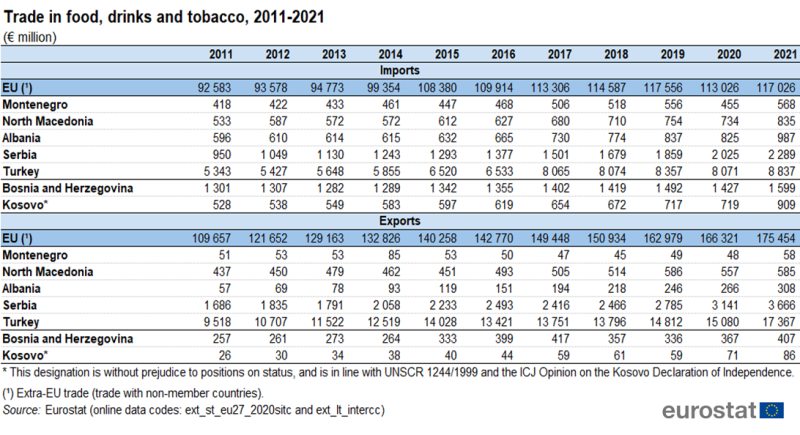
(€ million)
Source: Eurostat (ext_st_eu27_2020sitc) and (ext_lt_intercc)
For imports of food, drinks and tobacco among the Western Balkans and Türkiye, the highest value was also recorded in Türkiye with €12.0 billion in 2022. This corresponded to more than half (57.0 %) of the food, drinks and tobacco imported to the Western Balkans and Türkiye. Serbia (€3.0 billion), Bosnia and Herzegovina (€2.0 billion), Albania (€1.2 billion), Kosovo (€1.1 billion) and North Macedonia (€1.0 billion) were the other Western Balkans countries for which these imports exceeded €1 billion. Imports of food, drinks and tobacco were valued at €755 million for Montenegro.
Imports of food, drinks and tobacco to Bosnia and Herzegovina increased by 55.8 % in 2022 compared with 2012, the smallest overall change rate among the Western Balkans and Türkiye. North Macedonia and Montenegro followed with increases of 71.1 % and 79.1 %, respectively. Albania, recorded an increase of 91.1 % over the decade. The increase in the imports of food, drinks and tobacco to Serbia was the highest, almost trebling (+185.0 %) between 2012 and 2022; it doubled to Türkiye and Kosovo (+122.0 % and +107.9 %, respectively) over the same period.
The imports of food drinks and tobacco, as for exports, recorded growths in all the countries from 2021 to 2022. The strongest growths were registered in Türkiye (+36.3 %), Montenegro (+32.9 %) and Serbia (+30.6 %). The recovery was less accentuated but still over 20 % for Bosnia and Herzegovina (+27.4 %) Kosovo (+22.3 %) and North Macedonia (+20.3 %). The lowest increase of imports of food, drinks and tobacco between 2021 and 2022 was recorded in Albania (+18.2 %).
Serbia and Türkiye recorded trade surpluses for food, drinks and tobacco throughout the period from 2012 to 2022. All the other Western Balkans and Türkiye recorded trade deficits for food, drinks and tobacco in each year of this period.
The EU consistently recorded a trade surplus in food, drinks and tobacco products over the period 2012-2022; note that the trade data presented for the EU in Table 3 concern extra-EU trade only, and do not include trade between the EU Member States.
Source data for tables and graphs
Data sources
The enlargement countries are expected to increase the volume and quality of their data progressively, and to transmit these data to Eurostat and the wider ESS in the context of the EU accession process. The final objective of the EU in relation to official statistics is to obtain harmonised, high-quality data that conforms to both European and international standards. More details on the statistical aspects of the accession process can be found in the article Enlargement policy and statistical cooperation.
The enlargement countries are not at the same level of development and are progressing towards an efficient and modern statistical system at different speeds. In a number of areas, candidate countries (and sometimes also potential candidates) are in a position to provide harmonised data in accordance with the EU acquis with respect to methodology, classifications and procedures for data collection and the principles of official statistics as laid down in the European statistics Code of Practice. In these cases, the candidate countries (and potential candidates) concerned report their data to Eurostat following the same procedures and under the same quality criteria as the EU Member States and the EFTA countries. Data from the enlargement countries that meet these quality requirements are published along with data for EU Member States and EFTA countries.
In addition, the enlargement countries provide data for a wide range of indicators for which they do not yet fully adhere to the quality requirements specified in the EU acquis and the methodology, classifications and procedures for data collection specified in the relevant Regulations, Directives and other legal documents. These data are collected on an annual basis through a questionnaire sent by Eurostat to the candidate countries or potential candidates. A network of contacts has been established for updating these questionnaires, generally within the national statistical offices, but potentially including representatives of other data-producing organisations (for example, central banks or government ministries). This annual exercise also provides an opportunity to provide methodological recommendations to the enlargement countries.
The situation for international trade statistics is somewhat different, as more detailed international trade statistics are available from Eurostat's Comext database.
All statistics presented in this article as monetary values in euro terms are based on current price series.
The utilised agricultural area describes the area used for farming. It includes arable land, permanent grassland, permanent crops (such as orchards, olive trees and vineyards) and other agricultural land such as kitchen gardens. Eurostat collects annual data on 18 categories and sub-categories of UAA from the EU Member States, EFTA countries and from the candidate and potential candidate countries in connection with the annual statistics on crop production. This is based on Regulation (EC) No 543/2009 concerning crop statistics and its amended annex (Commission Delegated Regulation (EU) No 2015/1557). In addition, data on UAA are collected through the Farm structure survey (FSS), also known as survey on the structure of agricultural holdings. FSS is conducted every 3 or 4 years as a sample survey, and once in ten years as a census. The data collections are organised in line with the EU legislation. For 2020 (the agricultural census), 2023 and 2026, they are organised in line with the Regulation (EU) 2018/1091 on integrated farm statistics and have a new structure, consisting of a core data set and several modules. More details can be found in the FSS metadata.
Statistics on crop production relate to harvested production. Cereals include wheat (common wheat and spelt and durum wheat), rye, maslin, barley, oats, mixed grain other than maslin, grain maize, sorghum, triticale, and other cereal crops such as buckwheat, millet, canary seed and rice. The annual statistics on production of different crops are based on data provided under Regulation (EC) No 543/2009 concerning crop statistics and its amended annex (Commission Delegated Regulation (EU) No 2015/1557). Eurostat receives and publishes harmonised statistical data from EU Member States, from the EFTA countries and from the candidate and potential candidate countries
Meat production is based on the activity of slaughterhouses regarding meat fit for human consumption and estimates for production outside of slaughterhouses. Livestock and meat statistics are collected under Regulation (EC) No 1165/2008 concerning livestock and meat statistics. They cover meat production, as activity of slaughterhouses (monthly) and as other slaughtering (annual), meat production forecast (semi-annual or quarterly) and livestock statistics, including regional statistics. Slaughterings outside slaughterhouses, including on farms for own consumption, are collected based on a gentlemen's agreement (ASA/TE/763) if they are considered significant for estimating total national (and/or EU) production. More details can be found in the Animal production statistics metadata and in the draft Handbook on meat statistics (2021).
Tables in this article use the following notation:
| Value in italics | data value is forecasted, provisional or estimated and is therefore likely to change; |
| : | not available, confidential or unreliable value. |
Context
Agriculture was one of the first sectors of the economy (following coal and steel) to receive the attention of EU policymakers, and statistics on agriculture were initially designed to monitor the main objectives of the common agricultural policy (CAP). While the CAP remains one of the EU's most important policies there have been wide ranging reforms, which have led to a range of new objectives designed to correct imbalances and overproduction.
In December 2013, a reform of the CAP was formally adopted by the European Parliament and the Council. The main objectives of the CAP for the period 2014-2020 was to strengthen the competitiveness of the sector, promote sustainable farming and innovation, to support jobs and growth in rural areas and to move financial assistance towards the productive use of land. In 2018, the European Commission presented legislative proposals for a new, reformed Common Agricultural Policy (CAP) beyond 2020. The reformed CAP should be key to helping the European Union achieving the objectives of the European Green Deal, and 40 % of the funds allocated to the CAP over the next 7-years programming period should be dedicated to actions contributing towards these. The reformed CAP will help European farmers to contribute more decisively to tackling climate change, protecting the environment and moving to more sustainable and resilient food systems. It will generate economic opportunities for farmers and improve their position in the food supply chain, and better link support for farm income and rural areas to the take-up of sustainable models and practices.
On 2 December, 2021, the agreement on reform of the common agricultural policy (CAP) was formally adopted. The new legislation paves the way for a fairer, greener and more performance-based CAP. The reform covers three regulations, which apply from 1 January 2023:
For the years 2021-22, a transitional regulation (Regulation (EU) 2020/2220) was in force, extending and amending provisions set out in the preceding regulations. While basic principles and institutional frameworks for producing statistics are already in place, the Western Balkans and Türkiye are expected to increase progressively the volume and quality of their data and to transmit these data to Eurostat in the context of the EU enlargement process. EU standards in the field of statistics require the existence of a statistical infrastructure based on principles such as professional independence, impartiality, relevance, confidentiality of individual data and easy access to official statistics; they cover methodology, classifications and standards for production.
Eurostat has the responsibility to monitor that statistical production of the Western Balkans and Türkiye complies with the EU acquis in the field of statistics. To do so, Eurostat supports the national statistical offices and other producers of official statistics through a range of initiatives, such as pilot surveys, training courses, traineeships, study visits, workshops and seminars, and participation in meetings within the European Statistical System (ESS). The ultimate goal is the provision of harmonised, high-quality data that conforms to European and international standards. Additional information on statistical cooperation with the Western Balkans and Türkiye is provided here.
Agriculture is one of the most complex, sensitive and critical issues in the enlargement process due to its significant size (share of GDP and the high proportion of the population active in agriculture), as well as its structural deficiencies (subsistence and semi-subsistence farming).
Accession negotiations in agriculture focus on the procedures for future direct payments, support for rural development and the need for transitional measures to allow for integration into the EU, taking into account the specific circumstances of the agricultural sector in each country.
A large number of binding rules and their effective enforcement by an efficient public administration are essential for the functioning of the CAP. This includes the laws governing management systems, such as a paying agency and the integrated administration and control system, and also the capacity to implement rural development actions.
EU membership requires the integration of a range of agricultural products, including arable crops, sugar, animal products and specialised crops, into the common organisation of the market. A list of the current European legislation on agriculture statistics can be found here.
The European Commission experts in the field of agriculture and rural development provide assistance and guidance to candidate and potential candidate countries in preparing for future accession to the EU and more specifically, the common agricultural policy (CAP) and rural development.
Direct access to
- Enlargement countries — statistical overview — online publication
- International statistical cooperation — online publication
- All articles on agriculture
- Statistical books/pocketbooks
- Key figures on enlargement countries — 2019 edition
- Key figures on enlargement countries — 2017 edition
- Key figures on the enlargement countries — 2014 edition
- Key figures on the European food chain — 2021 edition
- Agriculture, forestry and fishery statistics — 2020 edition
- Agriculture, forestry and fishery statistics — 2019 edition
- Factsheets
- Basic figures on the candidate countries and potential candidates — Factsheets — 2023 edition
- Basic figures on Western Balkans and Turkey — Factsheets — 2022 edition
- Basic figures on enlargement countries — Factsheets — 2021 edition
- Leaflets
- Basic figures on enlargement countries — 2020 edition
- Basic figures on enlargement countries — 2019 edition
- Basic figures on enlargement countries — 2018 edition
- Basic figures on enlargement countries — 2016 edition
- Enlargement Countries - Agriculture, forestry and fisheries — 2014 edition
- Agriculture (t_agri), see:
- Agricultural production (t_apro)
- Crops products (t_apro_cp)
- Milk and milk products (t_apro_mk)
- Livestock and meat (t_apro_mt)
- International trade in goods – long-term indicators (t_ext_go_lti)
- International trade (t_ext_go_lti_int)
- International trade of food, drinks and tobacco (SITC 0+1), by reporting country (tet00005)
- EU27 (from 2020) trade by Member State, partner and product group (t_ext_go_lti_ext1)
- Extra-EU27 (from 2020) trade of food, drinks and tobacco (SITC 0+1), by Member State (tet00014)
- International trade (t_ext_go_lti_int)
- Agriculture (agri), see:
- Agricultural production (apro)
- Crops (apro_crop)
- Crop production (apro_cp)
- Crop production in national humidity (from 2000 onwards) (apro_cpnh)
- Crop production (apro_cp)
- Animal production (apro_anip)
- Poultry farming (apro_ec)
- Milk and milk products (apro_mk)
- Production and utilization of milk on the farm - annual data (apro_mk_farm)
- Livestock and meat (apro_mt)
- Meat production (apro_mt_p)
- Livestock (apro_mt_ls)
- Crops (apro_crop)
- International trade data (ext)
- International trade long-term indicators (ext_lti)
- International trade short-term indicators (ext_sti)
- International trade detailed data (detail)
- Farm structure (SIMS metadata file — ef_sims]
- Crop production (ESMS metadata file — apro_cp_esms)
- Animal production (ESMS metadata file — apro_anip_esms)
- Agricultural production data: methodological notes
- Draft Handbook on meat statistics (2021).
- Regulation (EC) No 543/2009 of 18 June 2009 concerning crop statistics
- Regulation (EC) No 1165/2008 of the European Parliament and of the Council of 19 November 2008 concerning livestock and meat statistics
- Directive 1996/16/EC of 19 March 1996 on statistical surveys of milk and milk products
- European Commission— Agriculture and rural development — Agriculture in EU enlargement
- European Commission — Agriculture and rural development — The new common agricultural policy 2023-27
- European Commission — Agriculture and rural development — Food, farming, fisheries
- European Commission — Agriculture and rural development — Plants and plant products
- European Commission — Agriculture and rural development — Fruit and vegetables
- European Commission — Agriculture and rural development — Animals and animal products
- European Commission — Agriculture and rural development — short- and medium term outlook and market reports for EU arable crops, dairy and meat markets
- European Commission – Agriculture and rural development — Trade and international policy analysis
